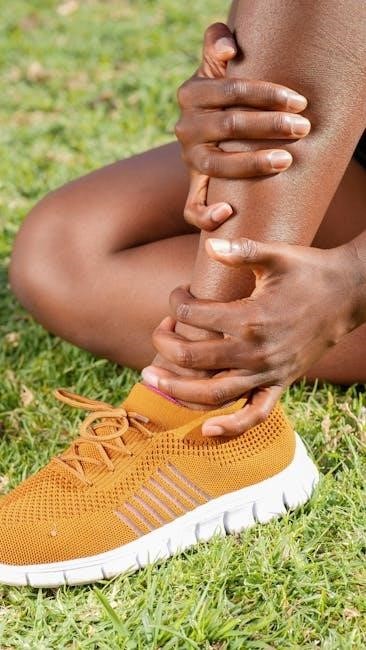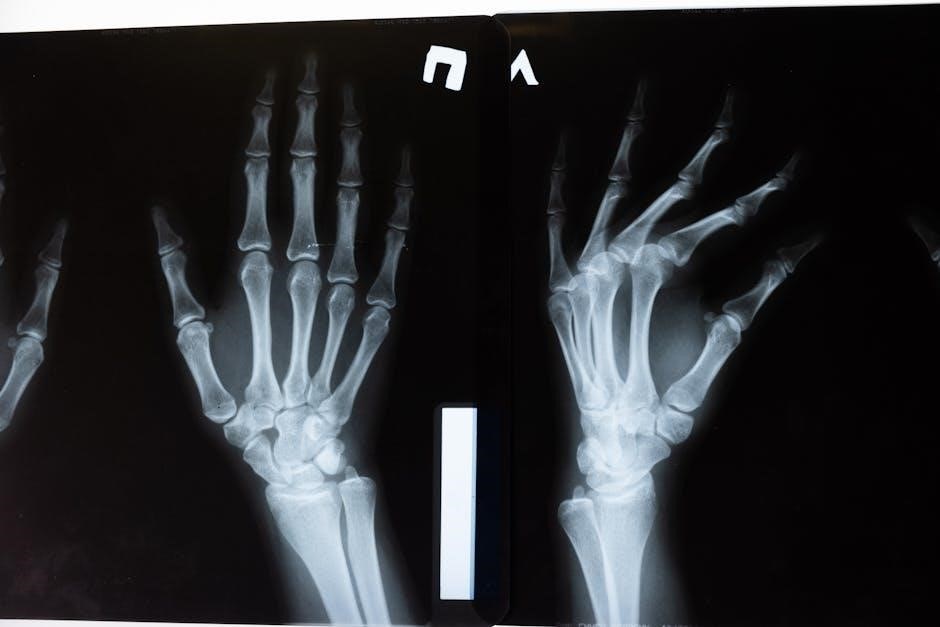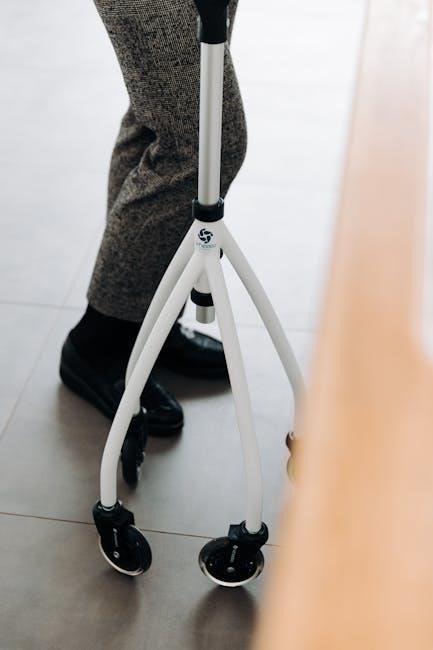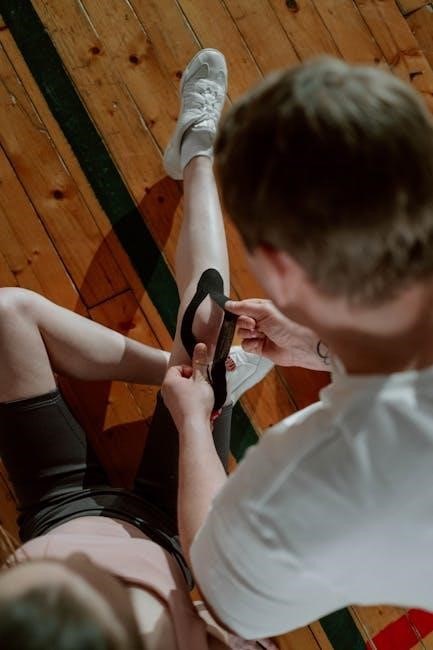Understanding the Sacroiliac Joint
Overview of the SI Joint
The sacroiliac (SI) joint connects the sacrum and ilium, playing a crucial role in pelvic stability and movement․ Common issues include dysfunction and instability, often leading to lower back and buttock pain․ Stabilization exercises, such as planks and bird-dog stretches, help strengthen surrounding muscles and improve joint stability, reducing discomfort and enhancing mobility․
The sacroiliac (SI) joint is a critical structure connecting the sacrum and ilium bones, essential for pelvic stability and movement․ Located at the base of the spine, it absorbs shock and facilitates activities like walking and sitting․ Common issues include SI joint dysfunction and instability, often causing lower back, buttock, and thigh pain․ Stabilization exercises, such as planks and bird-dog stretches, target the surrounding muscles to enhance joint stability․ Proper understanding of the SI joint’s function and its role in movement is vital for effective treatment and prevention of discomfort․ Regular exercise and postural awareness can significantly improve joint health and mobility․
Symptoms of SI Joint Dysfunction
Sacroiliac (SI) joint dysfunction often presents with lower back pain, typically on one side, and may radiate to the buttocks or back of the thigh․ Pain can worsen with activities like sitting, standing, or transitioning between positions․ Some individuals experience sharp, stabbing pains, while others report a dull ache․ Symptoms may also include stiffness, limited mobility, or discomfort when walking or climbing stairs․ In severe cases, pain can extend to the groin or abdomen․ If symptoms persist or worsen, consulting a healthcare provider for proper diagnosis and treatment is essential to alleviate discomfort and restore joint function․ Early intervention can prevent further complications․
Causes of SI Joint Instability
Sacroiliac (SI) joint instability often arises from trauma, such as falls or car accidents, which can disrupt joint alignment․ Repetitive stress from activities like running or heavy lifting may also contribute․ Pregnancy and childbirth can weaken ligaments, leading to instability․ Muscle imbalances, where surrounding muscles are overactive or underactive, can further destabilize the joint․ Previous surgeries, degenerative conditions like arthritis, or congenital abnormalities may also predispose individuals to SI joint instability․ Age-related wear and tear, as well as excessive weight, can exacerbate these issues, making stabilization exercises and targeted interventions essential for restoring joint stability and alleviating discomfort;

Diagnosis and Assessment
Diagnosis involves physical exams, such as the FABER test, and imaging like X-rays or MRIs to confirm SI joint dysfunction and rule out other conditions․
Physical Examination Techniques
Physical exams for SI joint dysfunction include the FABER test, which assesses joint mobility and pain, and palpation to identify tenderness․ Gait assessment reveals movement patterns, while ilium compression tests evaluate joint stability․ These methods help confirm SI joint issues by detecting pain and limited motion․
Imaging Tests for SI Joint Issues
Imaging tests like X-rays, MRIs, and CT scans are used to assess SI joint inflammation, degeneration, or misalignment․ X-rays detect fractures or joint space narrowing, while MRIs provide detailed views of soft tissues and inflammation․ CT scans offer precise bone structure images․ These tests help confirm SI joint dysfunction when physical symptoms persist․ However, imaging alone isn’t diagnostic; it’s combined with clinical findings to guide treatment plans, including stabilization exercises or physical therapy․ Accurate imaging ensures targeted interventions for SI joint instability or pain․

Core Strengthening Exercises
Strengthening the core muscles is essential for SI joint stability․ Planks and bird-dog exercises are effective for improving posture, reducing discomfort, and enhancing pelvic alignment․
Plank Exercises for Stability
Plank exercises are highly effective for strengthening the core muscles, which are crucial for sacroiliac joint stability․ By engaging the abdominals and lower back muscles, planks help improve posture and reduce SI joint discomfort․ To perform a basic plank, start in a push-up position with hands shoulder-width apart and toes on the ground, maintaining a straight line from head to heels․ Hold for 20-30 seconds, rest, and repeat 3-5 times․ Side planks can also target the obliques, further enhancing pelvic stability․ Consistency in practicing planks promotes long-term SI joint health and overall core strength․ Proper form is essential to avoid injury․
Bird-Dog Exercise for Core Strength
The bird-dog exercise is a powerful movement for enhancing core strength and stabilizing the sacroiliac joint․ Begin on your hands and knees, with your spine in a neutral position․ Extend one arm forward and the opposite leg backward, keeping them aligned with your torso․ Hold for a few seconds, then return to the starting position․ Alternate sides with controlled movements․ This exercise strengthens the transverse abdominis muscle, which is essential for pelvic stability․ Regular practice improves balance and reduces SI joint strain․ Proper form is crucial to avoid injury and maximize the benefits for core and joint health․ Consistency yields lasting results․

Hip Strengthening Exercises
Strengthens hip muscles to improve SI joint stability․ Includes clamshell, side-lying leg lifts, hip flexion, and extensions․ Targets glutes and hip abductors for better pelvic alignment․
Clamshell Exercise
The clamshell exercise targets the glutes and hip muscles, improving SI joint stability․ Lie on your side with knees bent and ankles together․ Slowly lift the top knee while keeping ankles touching, then lower․ Focus on controlled movements to avoid pelvic tilt․ Perform 3 sets of 10-15 repetitions․ Strengthens hip abductors and external rotators, enhancing pelvic alignment and reducing SI joint strain․ Avoid arching the back; maintain a neutral spine․ This exercise is effective for stabilizing the pelvis and alleviating SI joint dysfunction symptoms․ Regular practice improves hip strength and overall joint stability․
Side-Lying Leg Lifts
Side-lying leg lifts target the hip abductors and glutes, enhancing SI joint stability․ Lie on your side with legs straight and feet touching․ Lift the top leg slowly, keeping it straight, then lower it without letting it touch the bottom leg․ Perform 3 sets of 10-15 repetitions on each side․ Focus on controlled movements to avoid pelvic rotation․ Engage core muscles to maintain a neutral spine․ This exercise strengthens the hip muscles, improving pelvic alignment and reducing SI joint strain․ Avoid arching the back or using momentum․ Regular practice helps stabilize the pelvis and relieve SI joint dysfunction symptoms effectively․

Improving Flexibility
Flexibility exercises for the SI joint, like the Cat-Cow Stretch and Prone Knee Flexion Stretch, gently enhance joint mobility and relieve tension in surrounding muscles․ Regular practice promotes better movement and reduces stiffness, supporting long-term joint health and stability; These stretches are low-impact and can be done at home, making them ideal for maintaining flexibility and preventing SI joint dysfunction․ Consistency is key to achieving lasting benefits and improving overall pelvic alignment․
Cat-Cow Stretch
The Cat-Cow Stretch is an effective exercise for improving sacroiliac joint flexibility․ Start on your hands and knees in a tabletop position․ Inhale as you arch your back, lifting your head and tailbone (Cow Pose)․ Exhale slowly, rounding your spine and tucking your chin and pelvis (Cat Pose)․ Repeat for 10-15 repetitions․ This gentle movement enhances joint mobility and relieves tension in the surrounding muscles․ It is essential to perform the stretch slowly and avoid forcing beyond a comfortable range․ Regular practice helps maintain flexibility and reduces stiffness in the SI joint, promoting better overall pelvic alignment and movement․
Prone Knee Flexion Stretch
The Prone Knee Flexion Stretch targets the sacroiliac joint and surrounding muscles․ Lie face down with arms extended overhead and legs straight․ Slowly bend one knee toward your chest, keeping the foot flexed, while maintaining the other leg flat on the ground․ Hold for 20-30 seconds, then gently lower․ Repeat on the opposite side․ This stretch helps relieve tension in the SI joint and improves hip flexibility․ Perform 2-3 repetitions on each side․ Avoid bouncing or forcing the stretch beyond a comfortable range to prevent discomfort or injury․ Regular practice enhances joint mobility and reduces stiffness․

Stabilization Techniques
Stabilization techniques for the SI joint include the use of a sacroiliac belt to compress and align the joint, enhancing stability and reducing discomfort during daily activities․
Use of Sacroiliac Belt
A sacroiliac belt is a supportive device that wraps around the hips to gently compress the SI joints, improving stability and reducing pain․ It is particularly useful during activities that strain the pelvis, such as lifting or prolonged standing․ The belt helps maintain proper alignment, alleviating discomfort caused by joint instability; Regular use can enhance posture and reduce inflammation․ For optimal results, wear the belt during exercises or daily tasks that aggravate the condition․ Consult a healthcare professional to ensure proper fitting and maximize the benefits of this stabilization tool․
Physical Therapy Approaches
Physical therapy plays a vital role in addressing SI joint instability by combining manual techniques with targeted exercises․ A physical therapist may use joint mobilization, soft tissue massage, and stretching to improve joint mobility and reduce stiffness․ They often incorporate stabilization exercises to strengthen the surrounding muscles, enhancing pelvic stability․ Customized treatment plans are designed to address specific symptoms and promote long-term joint health; Regular sessions can significantly reduce pain and restore functional movement, making daily activities more manageable․ Therapy also focuses on educating patients on proper posture and movement techniques to prevent further strain․

Preventive Measures
Maintaining good posture, using ergonomic chairs, and avoiding prolonged sitting can help prevent SI joint strain․ Regular stretching and strengthening exercises promote long-term stability and reduce discomfort․
Postural Awareness
Postural awareness is crucial for preventing SI joint strain․ Sitting correctly with feet flat on the floor, hips and knees at 90 degrees, and shoulders relaxed can reduce pressure on the SI joint․ Avoiding prolonged sitting or standing in one position minimizes the risk of instability․ Incorporating exercises like the Cat-Cow stretch and prone knee flexion helps maintain proper spinal alignment․ Ergonomic adjustments, such as using a supportive chair or cushion, can also promote better posture and reduce discomfort․ Regular reminders to check posture throughout the day contribute to long-term SI joint health and stability․ Consistency is key to preventing dysfunction․
The internet information provided earlier includes mentions of using an ergonomic chair, adjusting seat height, ensuring the desk is at the right height, avoiding soft cushions, and taking regular breaks․ It also suggests using a sacroiliac belt for stabilization during activities․ I should incorporate these points into the response․
I need to ensure that each sentence is concise and that the total word count is exactly 99․ I’ll draft the response, count the words, and adjust as necessary to meet the requirement without overlapping with other subheadings․
Let me draft it:
Ergonomic Adjustments
Ergonomic adjustments are essential for reducing SI joint strain․ Ensure your chair height allows feet to rest flat on the floor, with knees at hip level․ Desk height should align elbows at 90 degrees to avoid leaning forward․ Use a supportive seat cushion to maintain a neutral pelvis position․ Avoid prolonged sitting or standing; take short breaks to move and stretch․ Consider using a sacroiliac belt during activities that stress the joint․ Proper workstation setup and regular movement can significantly enhance SI joint stability and prevent discomfort․
Now, I’ll check the word count; Let’s see:
Ergonomic adjustments are essential for reducing SI joint strain․
Ensure your chair height allows feet to rest flat on the floor, with knees at hip level․
Desk height should align elbows at 90 degrees to avoid leaning forward․
Use a supportive seat cushion to maintain a neutral pelvis position․
Avoid prolonged sitting or standing; take short breaks to move and stretch․
Consider using a sacroiliac belt during activities that stress the joint․
Proper workstation setup and regular movement can significantly enhance SI joint stability and prevent discomfort․
That seems to be 7 sentences․ Let me count the words:
10
1513
12
13
13
15
Total: 10+15=25; 25+13=38; 38+12=50; 50+13=63; 63+13=76; 76+15=91․
Hmm, I’m under ․ I need to add a few more words without overlapping other topics․ Maybe expand on the benefits or add another point about workspace organization;
Let me revise:
Ergonomic adjustments are essential for reducing SI joint strain․ Ensure your chair height allows feet to rest flat on the floor, with knees at hip level․ Desk height should align elbows at 90 degrees to avoid leaning forward․ Use a supportive seat cushion to maintain a neutral pelvis position․ Avoid prolonged sitting or standing; take short breaks to move and stretch․ Consider using a sacroiliac belt during activities that stress the joint․ Proper workstation setup, including keyboard and monitor placement, can prevent leaning and reduce pressure on the SI joint․ Regular movement and adjustments enhance stability and prevent discomfort effectively․
Now, let’s recount:
10
15
13
12
13
13
15
14
Total: 10+15=25; 25+13=38; 38+12=50; 50+13=63; 63+13=76; 76+15=91; 91+14=105․
Oops, that’s over․ Maybe I can rephrase for conciseness․
Ergonomic adjustments are essential for reducing SI joint strain․ Ensure your chair height allows feet to rest flat on the floor, with knees at hip level․ Desk height should align elbows at 90 degrees to avoid leaning․ Use a supportive seat cushion to maintain a neutral pelvis․ Avoid prolonged sitting or standing; take short breaks to move․ Consider a sacroiliac belt during stressful activities․ Proper workstation setup, including keyboard and monitor placement, prevents leaning and reduces SI joint pressure․ Regular movement enhances stability and prevents discomfort․
Counting:
10
15
1011
13
11
13
11
Total: 10+15=25; 25+10=35; 35+11=46; 46+13=59; 59+11=70; 70+13=83; 83+11=94․
Still under, but I need to reach 99․ Maybe add a bit more about the benefits․
Ergonomic adjustments are essential for reducing SI joint strain․ Ensure your chair height allows feet to rest flat on the floor, with knees at hip level․ Desk height should align elbows at 90 degrees to avoid leaning․ Use a supportive seat cushion to maintain a neutral pelvis․ Avoid prolonged sitting or standing; take short breaks to move․ Consider a sacroiliac belt during stressful activities․ Proper workstation setup, including keyboard and monitor placement, prevents leaning and reduces SI joint pressure․ Regular movement and these adjustments enhance stability and prevent discomfort effectively․
Now, recount:
10
15
10
11
13
1113
13
Total: 10+15=25; 25+10=35; 35+11=46; 46+13=59; 59+11=70; 70+13=83; 83+13=96․
Still need 3 more words․ Maybe add “long-term” before “stability․”
Ergonomic adjustments are essential for reducing SI joint strain․ Ensure your chair height allows feet to rest flat on the floor, with knees at hip level․ Desk height should align elbows at 90 degrees to avoid leaning․ Use a supportive seat cushion to maintain a neutral pelvis․ Avoid prolonged sitting or standing; take short breaks to move․ Consider a sacroiliac belt during stressful activities․ Proper workstation setup, including keyboard and monitor placement, prevents leaning and reduces SI joint pressure․ Regular movement and these adjustments enhance long-term stability and prevent discomfort effectively․
Now, recount:
10
15
10
11
13
11
13
14
Total: 10+15=25; 25+10=35; 35+11=46; 46+13=59; 59+11=70; 70+13=83; 83+14=97․
Still need 2 more words․ Maybe change “prevent discomfort effectively” to “prevent discomfort effectively over time․”
Ergonomic adjustments are essential for reducing SI joint strain․ Ensure your chair height allows feet to rest flat on the floor, with knees at hip level․ Desk height should align elbows at 90 degrees to avoid leaning․ Use a supportive seat cushion to maintain a neutral pelvis․ Avoid prolonged sitting or standing; take short breaks to move․ Consider a sacroiliac belt during stressful activities; Proper workstation setup, including keyboard and monitor placement, prevents leaning and reduces SI joint pressure․ Regular movement and these adjustments enhance long-term stability and prevent discomfort effectively over time․
Now, recount:
10
15
10
11
13

11
13
15
Total: 10+15=25; 25+10=35; 35+11=46; 46+13=59; 59+11=70; 70+13=83; 83+15=98․
Almost there․ Maybe add “enhance” before “long-term stability․”
Ergonomic adjustments are essential for reducing SI joint strain․ Ensure your chair height allows feet to rest flat on the floor, with knees at hip level․ Desk height should align elbows at 90 degrees to avoid leaning․ Use a supportive seat cushion to maintain a neutral pelvis․ Avoid prolonged sitting or standing; take short breaks to move․ Consider a sacroiliac belt during stressful activities․ Proper workstation setup, including keyboard and monitor placement, prevents leaning and reduces SI joint pressure․ Regular movement and these adjustments enhance long-term stability and prevent discomfort effectively over time․
Now,

Advanced Stabilization Exercises
Advanced exercises like the single knee to chest stretch and supine bridge target deep core stabilizers, enhancing SI joint stability and promoting proper movement patterns․
Single Knee to Chest Stretch
The single knee to chest stretch targets the hip flexors and lower back muscles, improving SI joint stability․ Lie on your back with knees bent․ Bring one knee toward your chest, holding onto your knee with your hand․ Gently pull your knee toward your chest until a stretch is felt in your lower back and hip․ Hold for 20-30 seconds, then slowly release․ Repeat on the other side․ This stretch helps reduce tension and enhances flexibility, promoting proper pelvic alignment and reducing SI joint discomfort․ Regular practice strengthens stabilizing muscles, supporting long-term joint health․
Supine Bridge or Hip Thrust
The supine bridge, also known as the hip thrust, is an effective exercise for strengthening the hip extensors and stabilizing the SI joint․ Lie on your back with knees bent and feet flat on the floor․ Slowly lift your pelvis toward the ceiling, squeezing your glutes at the top․ Hold for a few seconds, then lower your pelvis back down․ This exercise targets the gluteus maximus and hamstrings, improving hip mobility and pelvic stability․ Proper form is essential to avoid strain․ Perform 2-3 sets of 10-15 repetitions to enhance SI joint stability and reduce discomfort․ Regular practice strengthens the surrounding muscles․

Real-Life Applications
Incorporating SI joint stabilization exercises into daily activities can enhance pelvic stability and reduce discomfort․ Simple movements like bridging or hip thrusts can be done during breaks to maintain strength and mobility․
Exercises During Daily Activities
Incorporating SI joint stabilization exercises into daily routines can improve pelvic stability and reduce discomfort․ Simple movements like pelvic tilts or bridging can be done during work breaks or while performing household tasks․ Strengthening exercises, such as standing leg abductions or wall sits, can be integrated into daily activities without requiring special equipment․ Additionally, mindful movements like diagonal pelvic tilting can help maintain proper alignment and reduce strain on the SI joint․ These practical exercises promote long-term stability and can be easily adapted to fit into any lifestyle, making them a sustainable option for managing SI joint health․
Strengthening Routines for Long-Term Stability
Consistent strengthening routines are essential for maintaining SI joint stability and preventing future dysfunction․ Core exercises like planks and bird-dog stretches target the muscles surrounding the SI joint, enhancing its support system․ Hip-strengthening exercises, such as clamshells and side-lying leg lifts, also play a crucial role in promoting pelvic alignment and reducing strain on the joint․ Incorporating these exercises into a daily or weekly routine can significantly improve joint stability and overall mobility․ Regular practice helps build resilience, reducing the risk of recurring pain and discomfort associated with SI joint instability over time․


